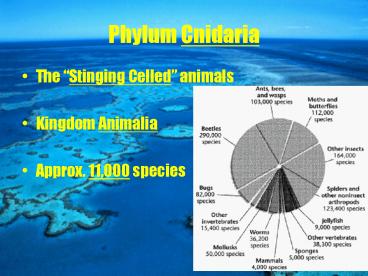Phylum Cnidaria - PowerPoint PPT Presentation
1 / 27
Title:
Phylum Cnidaria
Description:
Phylum Cnidaria The Stinging Celled animals Kingdom Animalia Approx. 11,000 species * * * * * * * * * * * * * * * * * * * * * * Cnidarian Habitat All live in ... – PowerPoint PPT presentation
Number of Views:191
Avg rating:3.0/5.0
Title: Phylum Cnidaria
1
Phylum Cnidaria
- The Stinging Celled animals
- Kingdom Animalia
- Approx. 11,000 species
2
Cnidarian Habitat
- All live in water -aquatic
- Most live in saltwater - marine
- Few are freshwater ex. Hydra
3
Cnidarian Movement
- Some can move
- (motile)
- Some cannot move
- (non-motile)
4
General Cnidarian Info
- All are consumers
- They get food with stinging cells
- Cnidocytes
- Cnidocytes cover the tentacles only
- Prey is captured in tentacles stung to death
- When prey is dead it is stuffed into the gut
5
Diagram of Nematocyst
6
General Cnidarian Info
- What do they eat?
- Depends on the size
- Fish, worms, microorganisms, etc
- Cnidarians are Chunk Feeders
- Not filter feeders like sponges
7
Body Forms
- Polyp tube with tentacles
pointing up - Often sessile (attached)
- Medusa umbrella with
- tentacles hanging down
- Often float or use jet propulsion
8
Symmetry
- Radial symmetry (wheel-like body plan)
- No head/tail or front/back
9
Cnidarian Body Structure
- Inner Wall (Endoderm)
- 3 kinds of cells
- Cells that make digestive enzymes
- Cells with flagella to circulate fresh water from
outside - Cells that contain partially digested food which
is absorbed into the body - Outer wall - Ectoderm skin layer for protection
- Middle Jelly layer - mesoglea
- contains nerve net
- Hollow gut Gastrovascular cavity
10
Cnidarian Reproduction
- Reproduction sexual or asexual
- Sexual two parents - Sperm Egg
- Asexual one parent - budding
11
Coelenterate Examples
- Jellyfish, Portuguese Man-of-War, Sea Anemone,
Coral, Hydra
12
Jellyfish
- Named for thick layer of mesoglea
- Body form Medusa
- Size from a few mm to a few meters
- Dangerous Examples
- Sea Wasp Jellyfish
- Box Jellyfish
13
Jellyfish Pictures
14
Portuguese Man-of-War
- Looks like a floating plastic bag
- Body form Colonial
- Some polyp
- Some medusa
- Size from a few cm to over 1 meter
15
Portuguese Man-of-War
- Some are dangerous to humans, possibly even deadly
16
Sea Anemone
- Named for a flower
- Body form polyp
- Size from a few cm to over 1 meter
- Mostly non-motile, but some can glide slowly
17
Sea Anemone
- Many species live with a clownfish this is a
Mutualistic Relationship - The fish gets protection
- The anemone gets food lured by the brightly
colored fish
18
Coral
- All are non-motile
- Body form Polyp
- Size rarely larger than 1 mm
- Protection build a crater of limestone around
body
19
Coral
- Coral reefs
- Largest Coral Reef
- Great Barrier Reef in Australia
20
Hydra
- All live in freshwater
- Body form polyp
- Size max. ½ inch
- Move by gliding, somersaulting, floating
21
Comparing Sponges Coelenterates
- Number () of Species
- Habitat
- Symmetry
- Feeding
- Reproduction
- Movement
22
Comparing Sponges CoelenteratesNumber () of
Species
- Sponges
- Approx. 5,000
- Coelenterates
- Approx. 11, 000
23
Comparing Sponges CoelenteratesHabitat
- Sponges
- Mostly saltwater (marine)
- Some freshwater
- Coelenterates
- Mostly saltwater (marine)
- Some freshwater
24
Comparing Sponges CoelenteratesSymmetry
- Sponges
- Radial (wheel-like)
- Coelenterates
- Radial (wheel-like)
25
Comparing Sponges CoelenteratesFeeding Habits
- Sponges
- Filter Feeders
- Bacteria, algae, protozoans
- Coelenterates
- Chunk Feeders
- Fish, worms, some microorganisms
26
Comparing Sponges CoelenteratesReproduction
- Sponges
- Sexual sperm egg
- Asexual budding
- regeneration
- gemmules
- Coelenterates
- Sexual sperm egg
- Asexual - budding
27
Comparing Sponges CoelenteratesMovement
- Sponges
- All sessile (non-motile)
- Coelenterates
- Some motile
- Some sessile































